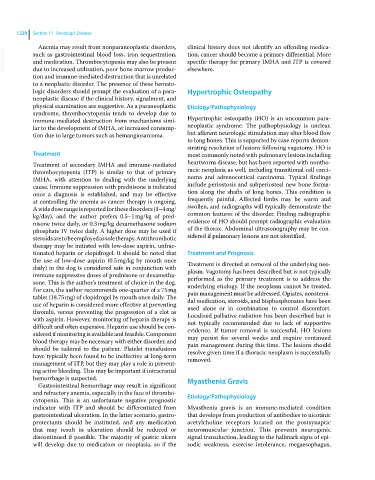Page 1282 - Clinical Small Animal Internal Medicine
P. 1282
1220 Section 11 Oncologic Disease
Anemia may result from nonparaneoplastic disorders, clinical history does not identify an offending medica-
VetBooks.ir such as gastrointestinal blood loss, iron sequestration, tion, cancer should become a primary differential. More
specific therapy for primary IMHA and ITP is covered
and medication. Thrombocytopenia may also be present
due to increased utilization, poor bone marrow produc-
tion and immune‐mediated destruction that is unrelated elsewhere.
to a neoplastic disorder. The presence of these hemato-
logic disorders should prompt the evaluation of a para- Hypertrophic Osteopathy
neoplastic disease if the clinical history, signalment, and
physical examination are suggestive. As a paraneoplastic Etiology/Pathophysiology
syndrome, thrombocytopenia tends to develop due to
immune‐mediated destruction from mechanisms simi- Hypertrophic osteopathy (HO) is an uncommon para-
lar to the development of IMHA, or increased consump- neoplastic syndrome. The pathophysiology is unclear,
tion due to large tumors such as hemangiosarcoma. but afferent neurologic stimulation may alter blood flow
to long bones. This is supported by case reports demon-
strating resolution of lesions following vagotomy. HO is
Treatment most commonly noted with pulmonary lesions including
Treatment of secondary IMHA and immune‐mediated heartworm disease, but has been reported with nontho-
thrombocytopenia (ITP) is similar to that of primary racic neoplasia as well, including transitional cell carci-
IMHA, with attention to dealing with the underlying noma and adrenocortical carcinoma. Typical findings
cause. Immune suppression with prednisone is indicated include periostosis and subperiosteal new bone forma-
once a diagnosis is established, and may be effective tion along the shafts of long bones. This condition is
at controlling the anemia as cancer therapy is ongoing. frequently painful. Affected limbs may be warm and
A wide dose range is reported for these disorders (1–4 mg/ swollen, and radiographs will typically demonstrate the
kg/day), and the author prefers 0.5–1 mg/kg of pred- common features of the disorder. Finding radiographic
nisone twice daily, or 0.3 mg/kg dexamethasone sodium evidence of HO should prompt radiographic evaluation
phosphate IV twice daily. A higher dose may be used if of the thorax. Abdominal ultrasonography may be con-
steroids are to be employed as sole therapy. Antithrombotic sidered if pulmonary lesions are not identified.
therapy may be initiated with low‐dose aspirin, unfrac-
tionated heparin or clopidrogel. It should be noted that Treatment and Prognosis
the use of low‐dose aspirin (0.5 mg/kg by mouth once Treatment is directed at removal of the underlying neo-
daily) in the dog is considered safe in conjunction with plasm. Vagotomy has been described but is not typically
immune suppressive doses of prednisone or dexametha- performed as the primary treatment is to address the
sone. This is the author’s treatment of choice in the dog. underlying etiology. If the neoplasm cannot be treated,
For cats, the author recommends one‐quarter of a 75 mg pain management must be addressed. Opiates, nonsteroi-
tablet (18.75 mg) of clopidrogel by mouth once daily. The dal medication, steroids, and bisphosphonates have been
use of heparin is considered more effective at preventing used alone or in combination to control discomfort.
thrombi, versus preventing the progression of a clot as Localized palliative radiation has been described but is
with aspirin. However, monitoring of heparin therapy is not typically recommended due to lack of supportive
difficult and often expensive. Heparin use should be con- evidence. If tumor removal is successful, HO lesions
sidered if monitoring is available and feasible. Component may persist for several weeks and require continued
blood therapy may be necessary with either disorder, and pain management during this time. The lesions should
should be tailored to the patient. Platelet transfusions resolve given time if a thoracic neoplasm is successfully
have typically been found to be ineffective at long‐term removed.
management of ITP, but they may play a role in prevent-
ing active bleeding. This may be important if intracranial
hemorrhage is suspected. Myasthenia Gravis
Gastrointestinal hemorrhage may result in significant
and refractory anemia, especially in the face of thrombo- Etiology/Pathophysiology
cytopenia. This is an unfortunate negative prognostic
indicator with ITP and should be differentiated from Myasthenia gravis is an immune‐mediated condition
gastrointestinal ulceration. In the latter scenario, gastro- that develops from production of antibodies to nicotinic
protectants should be instituted, and any medication acetylcholine receptors located on the postsynaptic
that may result in ulceration should be reduced or neuromuscular junction. This prevents neurogenic
discontinued if possible. The majority of gastric ulcers signal transduction, leading to the hallmark signs of epi-
will develop due to medication or neoplasia, so if the sodic weakness, exercise intolerance, megaesophagus,

